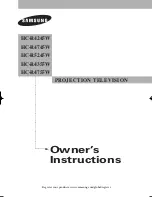
Functions
2.1 General
SIPROTEC, 7SD5, Manual
C53000-G1176-C169-5, Release date 02.2011
57
Example:
Transformer
Yy6d5
For the
Y
end set:
VECTOR GROUP I
=
0
,
For the
y
end set:
VECTOR GROUP I
=
6
,
For the
d
end set:
VECTOR GROUP I
=
5
.
If a different winding is selected as reference winding, e.g. the d winding, this has to be considered accordingly:
For the
Y
end set:
VECTOR GROUP I
=
7
(12 - 5),
For the
y
end set:
VECTOR GROUP I
=
1
(6 - 5),
For the
d
end set:
VECTOR GROUP I
=
0
(5 - 5 = 0 = reference side).
Address
1161
VECTOR GROUP U
is normally set to the same value as address
1162
VECTOR GROUP I
.
If the vector group of the transformer is adapted with external means, e.g. because there are matching trans-
formers in the measuring circuit that are still used, set
VECTOR GROUP I
=
0
at all ends. In this case the dif-
ferential protection operates without proper matching computation. However, the measuring voltages beyond
the transformer would then not be adapted in the device and therefore not be calculated and displayed correct-
ly. Address
1161
VECTOR GROUP U
eliminates this deficit. Set the correct vector group of the transformer ac-
cording to the above-mentioned considerations.
Address
1162
VECTOR GROUP I
is therefore relevant for the differential protection whereas address
1161
VECTOR GROUP U
serves as a basis for the calculation of the measured voltages beyond the transformer.
At address
1163
TRANS STP IS
you can enter whether the power transformer starpoint facing the device is
earthed or not. If the starpoint is earthed, the device will eliminate the zero sequence current of the relevant
side, since this zero sequence current can otherwise cause a spurious tripping in case of a ground fault outside
of the protected zone.
General Line Data of the Distance Protection
The information under this margin heading apply only to cases where the distance protection has been config-
ured as the main function or as a backup protection of the differential protection.
The settings of the line data in this case refer to the common data which is independent of the actual distance
protection grading.
The line angle (address
1105
Line Angle
) may be derived from the line parameters. The following applies:
where R
L
is the resistance and X
L
the reactance of the protected feeder. The line parameters may either apply
to the entire line length, or be per unit of line length as the quotient is independent of length. Furthermore, it
makes no difference whether the quotients are calculated with primary, or secondary values.
The line angle is of major importance, e.g. for earth impedance matching according to amount and angle or for
compounding in overvoltage protection.
Содержание SIPROTEC
Страница 20: ...Contents SIPROTEC 7SD5 Manual C53000 G1176 C169 5 Release date 02 2011 20 ...
Страница 351: ...Functions 2 18 Synchronism and Voltage Check optional SIPROTEC 7SD5 Manual C53000 G1176 C169 5 Release date 02 2011 351 ...
Страница 494: ...Functions 2 27 Command Processing SIPROTEC 7SD5 Manual C53000 G1176 C169 5 Release date 02 2011 494 ...
Страница 640: ...Technical Data 4 27 Dimensions SIPROTEC 7SD5 Manual C53000 G1176 C169 5 Release date 02 2011 640 ...
Страница 657: ...Appendix A 2 Terminal Assignments SIPROTEC 7SD5 Manual C53000 G1176 C169 5 Release date 02 2011 657 7SD5 W ...
Страница 754: ...Appendix A 10 Measured Values SIPROTEC 7SD5 Manual C53000 G1176 C169 5 Release date 02 2011 754 ...
Страница 756: ...Literature SIPROTEC 7SD5 Manual C53000 G1176 C169 5 Release date 02 2011 756 ...
Страница 768: ...Glossary SIPROTEC 7SD5 Manual C53000 G1176 C169 5 Release date 02 2011 768 ...







































